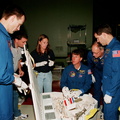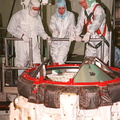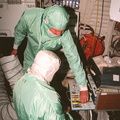
WIKIARCHIVES.SPACE
The Human Spaceflight Archive

Information
- Taken in
- Kennedy Space Center
- Auteur
- NASA
- Description
- In the mid-deck of the orbiter Discovery, STS-103 crew Commander Curtis L. Brown Jr. and Pilot Scott J. Kelly check out part of the equipment to be flown on the mission, the repair and upgrade of the Hubble Space Telescope. They are at KSC taking part in a Crew Equipment Interface Test along with other crew members Mission Specialists Steven L. Smith, C. Michael Foale (Ph.D.), John M. Grunsfeld (Ph.D.), Claude Nicollier of Switzerland, and Jean-François Clervoy of France. Nicollier and Clervoy are with the European Space Agency. Mission STS-103 is a "call-up" due to the need to replace portions of the pointing system, the gyros, which have begun to fail on the Hubble Space Telescope. Although Hubble is operating normally and conducting its scientific observations, only three of its six gyroscopes are working properly. The gyroscopes allow the telescope to point at stars, galaxies and planets. The STS-103 crew will not only replace gyroscopes, it will also replace a Fine Guidance Sensor and an older computer with a new enhanced model, an older data tape recorder with a solid-state digital recorder, a failed spare transmitter with a new one, and degraded insulation on the telescope with new thermal insulation. The crew will also install a Battery Voltage/Temperature Improvement Kit to protect the spacecraft batteries from overcharging and overheating when the telescope goes into a safe mode. The scheduled launch date in October is under review.
- Erstallt den
- Freiden 3 September 1999
- Source link
- https://science.ksc.nasa.gov/gallery/photos/1999/
- Visitten
- 38
- Bewäertungs-Stand
- nach keng Bewäertung
- Foto bewäerten
- License
- CC BY-NC-ND
- Modified by WikiArchives
- No (original)
- Downloads
- 0
Ennerstetzt vun Piwigo






